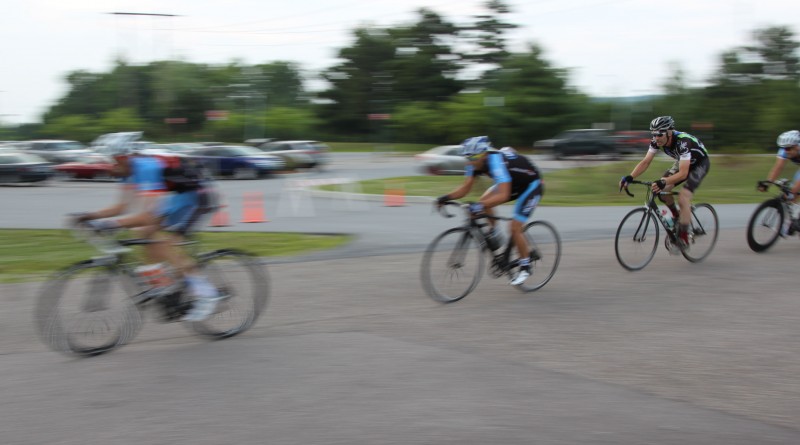Looking for a faster race? Try a Criterium
ESSEX JUNCTION — While many riders can tell tales of multiple-gap century rides through the Green Mountains, there’s more than one way to earn your bragging rights. If you’re all about speed, look no further than criterium racing.
Andre Sturm, a resident of Essex Junction, organizes spring and summer criterium races — “crits” for short — through the Green Mountain Bicycling Club. Sturm says the rides help cyclists develop skills for riding in larger groups, plus they offer intense interval workouts.
“Here, riders can practice riding consistently at speeds twenty to thirty-five per hour,” he says. “Typically, if you’re training in a group on the road, you don’t get an opportunity to practice those speeds with regularity.”
Criterium courses are short – some no longer than a half mile—but the sport demands both endurance and a powerful, sustained sprint.
Success in criterium racing also requires as much patience and strategy as it does power. During a race, riders pedal the course for a given amount of time determined by their class (beginners race 20 minutes, advanced racers pedal for 40). In that time, riders test their opponents’ limits by slowly ratcheting up the intensity of the pace. Racers that attempt to break away early inevitably fade as the rest of the pack drafts and works together to catch any ambitious racers.
Corners are a key strategic feature and play a crucial role in separating leaders from the pack. As riders enter a corner, the paceline comes together for a few intense moments as each rider attempts to take the shortest line possible around the turn. Like cars in a stock car race, the cyclists carefully position and control themselves through the turn and then sprint forward as the course straightens to create space they can maximize.
These “attacks,” are critical, as it gives riders a chance to catch the leaders or put space between them and others. But failing to anticipate the sudden sprints can be devastating, explains Sturm.
“If you’re in fifteenth position, you might be ten feet behind the first guy before the turn,” he says. “But sixteen or seventeen feet after the turn, if you’re at the back of the group, you have to accelerate harder to keep up because the first guy is already gone and you’ve lost a little bit of ground.”
This creates what he calls an “accordion effect” that separates the leaders from the rest of the field and any lapped riders are cut from the pack. The race finishes with a head-to-head battle to the finish line.
Courses are closed loops about a third of a mile long. Ideal courses are in industrial and commercial parks that have relatively closed loops of paved roads with predictable levels of traffic. Races are often held at the end of the workday when the offices have closed and the number of vehicles drops off, giving rides all over the country the fitting nickname “office park crits.”
On the evenings of races, course marshals sweep the course of dirt or gravel and position themselves at access points to the course, waving down and redirecting traffic and monitoring the races for crashes.
The Green Mountain Bike Club holds a series of practice criteriums over the summer at courses in Colchester and Essex. The course in Essex, located near the Edge Sport & Fitness center is flat with three 90-degree turns, while the course in Colchester on Water Tower Hill is on a hill, creating two different racing experiences.
“It’s a different workload,” he says. “On the hill, because of the profile of the course, you get your workout – twenty seconds on and twenty seconds off. But in Essex you have to work as a group.”
Some competitors who prefer the fast-pace style of the race use practice rides as preparation for the Queen City Criterium, the fourth and final stage of the Green Mountain Stage Race, held from Aug. 29 to Sept. 1. Featuring a variety of climbs, descents and six sharp corners starting and finishing on Main Street in downtown Burlington, the course is more technical and requires smart racing from participants in the 10 divisions (ranging from teens to seniors).
“A rider that is technically very savvy and race-smart can compensate for physical fitness quite a bit on that course,” says Sturm. “Also, the opposite is true; riders can be very fit and be dropped in the first lap because they lose contact with the field.”
That combination of fast-paced action and strategy is why Sturm enjoys organizing the crits.
“For some people, it’s about the high intensity training. But for other people who don’t want to travel three hours to races, this is their race. They come every other week and this is how they race.”


